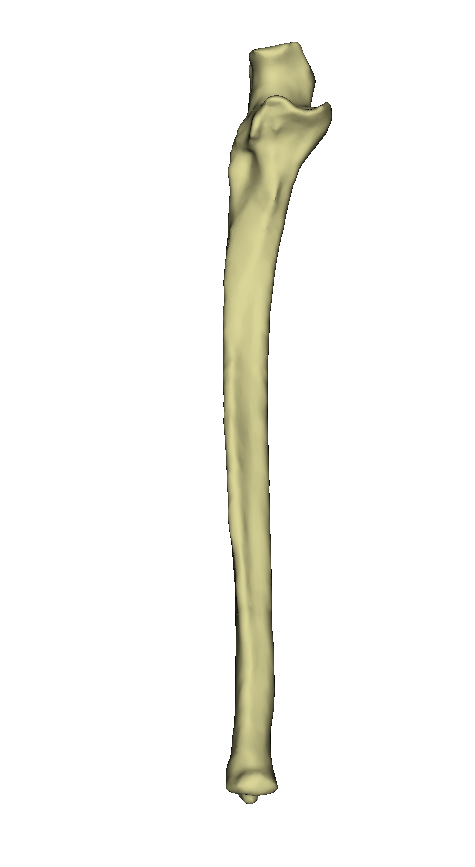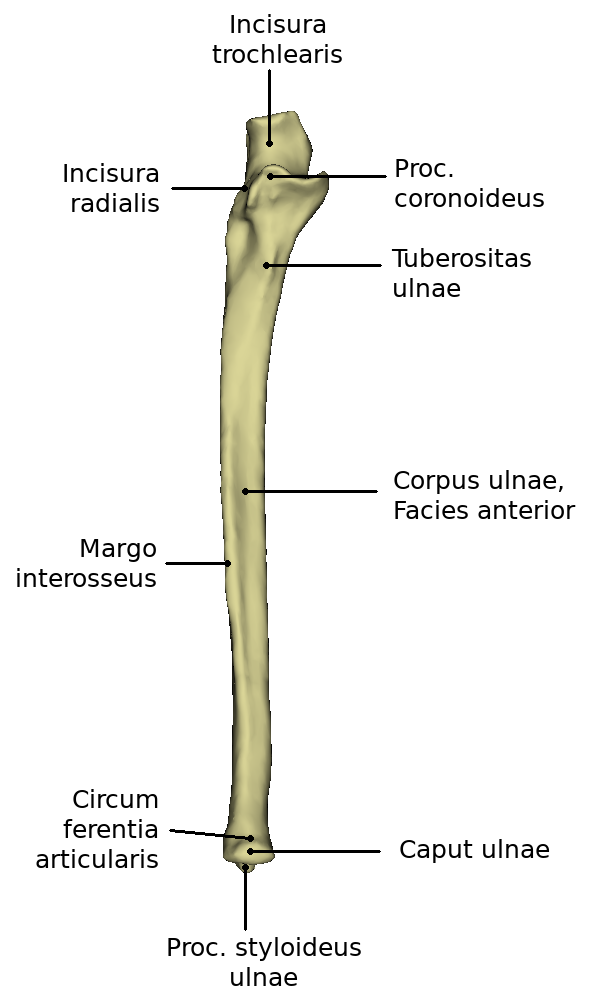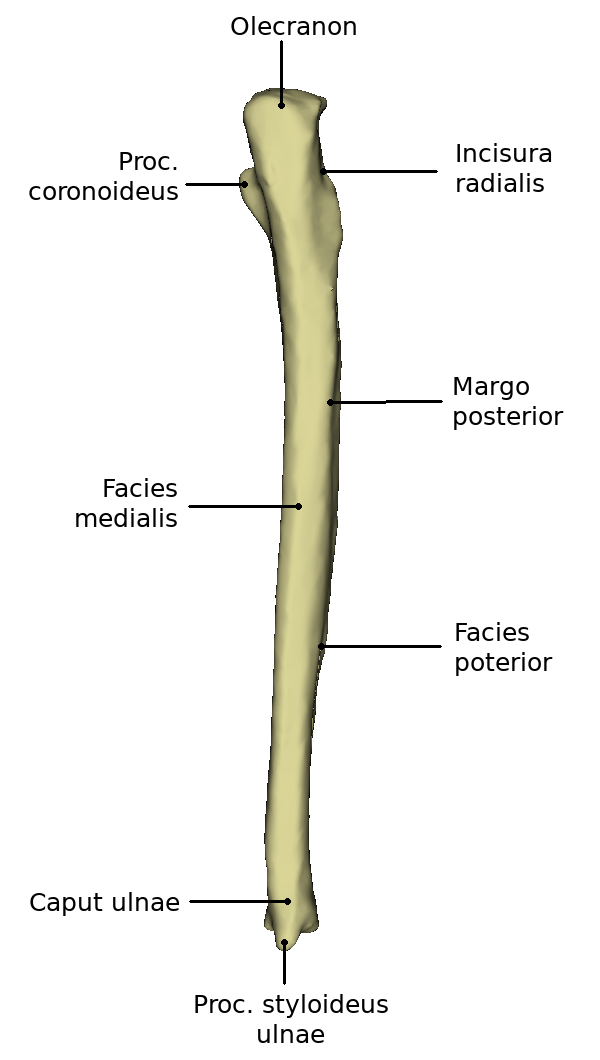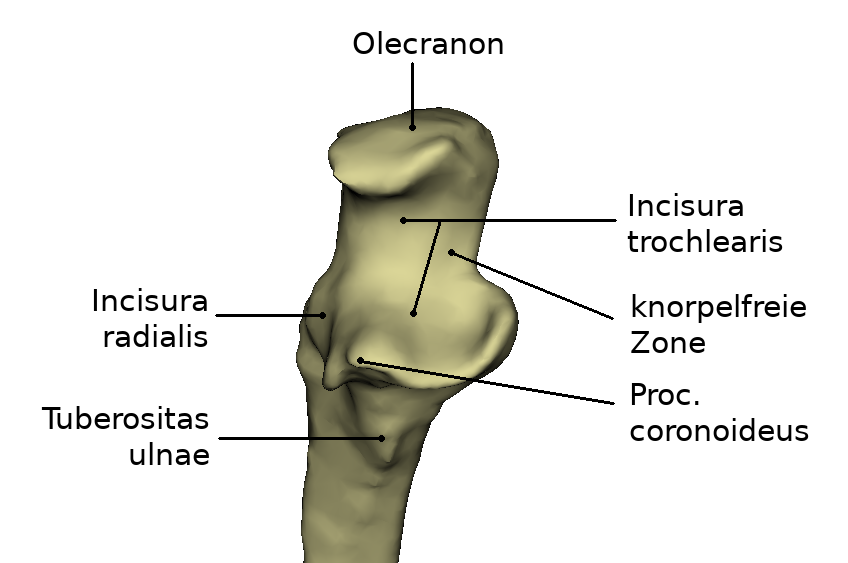Elle/en: Unterschied zwischen den Versionen
(Die Seite wurde neu angelegt: „=== Proximal end=== At the proximal extremity there is the hook-shaped bent extension, the olecranon. This has a certain roughness. In the front is the incisur…“) |
|||
| Zeile 47: | Zeile 47: | ||
The ulna has a corpus and one extremitas proximalis and distalis respectively. The Extremitas proximalis has a hook-shaped, roughened appendix, the Olecranon. In front is the Incisura trochlearis, which reaches up to the Processus coronoideus. Lateral is the Incisura radialis, into which the Circumferentia articularis (radii) is fitted. | The ulna has a corpus and one extremitas proximalis and distalis respectively. The Extremitas proximalis has a hook-shaped, roughened appendix, the Olecranon. In front is the Incisura trochlearis, which reaches up to the Processus coronoideus. Lateral is the Incisura radialis, into which the Circumferentia articularis (radii) is fitted. | ||
| − | === | + | === Proximal end=== |
| − | + | At the proximal extremity there is the hook-shaped bent extension, the olecranon. This has a certain roughness. In the front is the incisura trochlearis (3), which reaches up to the processus coronoideus. This depression is crescent-shaped and resembles a pair of forceps. Dorsally of these structures a roughened surface is found on the ulna. This is the attachment surface of the M. brachialis, the tuberosity ulnae. Lateral is the incisura radialis, into which the circumferentia articularis (radii) is fitted. | |
===Ulna-Schaft=== | ===Ulna-Schaft=== | ||
Version vom 26. Mai 2020, 13:10 Uhr
Together with the Radius the ulna forms the bones of the forearm. It is a typical long, straight tubular bone and lies on the side of the little finger in the arm.
Anatomy
The ulna has a corpus and one extremitas proximalis and distalis respectively. The Extremitas proximalis has a hook-shaped, roughened appendix, the Olecranon. In front is the Incisura trochlearis, which reaches up to the Processus coronoideus. Lateral is the Incisura radialis, into which the Circumferentia articularis (radii) is fitted.
Proximal end
At the proximal extremity there is the hook-shaped bent extension, the olecranon. This has a certain roughness. In the front is the incisura trochlearis (3), which reaches up to the processus coronoideus. This depression is crescent-shaped and resembles a pair of forceps. Dorsally of these structures a roughened surface is found on the ulna. This is the attachment surface of the M. brachialis, the tuberosity ulnae. Lateral is the incisura radialis, into which the circumferentia articularis (radii) is fitted.
Ulna-Schaft
Der Ulna-Schaft wird auch als Corpus ulnae bezeichnet. Der Querschnitt dieser Struktur weist eine dreieckige Form auf. So sind entlang dem Corpus ulnae drei Seiten und Kanten zu finden. Die Margo interosseus stellt die der Speiche zugewandte Seite dar. An dieser setzt die Membrana interossea antebrachii, die Elle und Speiche miteinander verbindet, an. Des Weiteren dient diese Kante als Trennung der Facies posterior und der Facies anterior. An der hinteren Seite der Ulna verläuft die Margo posterior. Diese zieht vom Olecranon bis hinunter zum Proc. styloideus am Caput ulnae. Angrenzend an diese Kante befinden sich sowohl die Facies posterior als auch die Facies medialis. Die mediale Fläche hat keine durchgehend einheitliche Form. Am proximalen Ende ist die Fläche deutlich breiter ausgeprägt als am distalen. Auch die Facies posterior ändert im Verlauf ihre Struktur. So weist sie am körpernahen Ende einen breiten und konkav gekrümmten Teil auf. Dieser wandelt sich in der Mitte zu einer schmaleren, konvexen Fläche. Das distale Ende dieser Fläche ist dann rundlich und eben.
Ulna-Kopf
Der Ulna-Kopf oder auch Caput ulnae besitzt an seinem distalen Ende das Proc. styloideus ulnae. Dieser wird auch als Griffelfortsatz bezeichnet und befindet sich an der kleinfingrigen Seite der distalen Gelenkfläche. Das distale Ende ist im allgemeinen verbreitert im Gegensatz zu dem davor verlaufenden Schaft.
Funktion
Die Elle bildet eine funktionelle Einheit mit dem Radius. Durch sie entsteht die Verbindung zwischen Ellenbogen- und Handgelenk. Die Möglichkeit der Überkreuzung der zwei Knochen erlaubt die Drehbewegungen des Unterarmes und der Hand.
Entwicklung
Der Corpus ulnae beginnt bereits in der siebten Embryonalwoche zu verknöchern. Das Verschließen der Epiphysenfugen beginnt zwischen dem vierten und siebten Lebensjahr.







